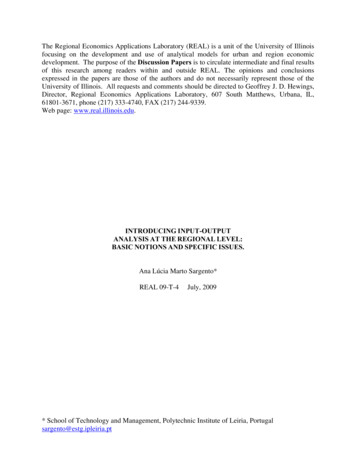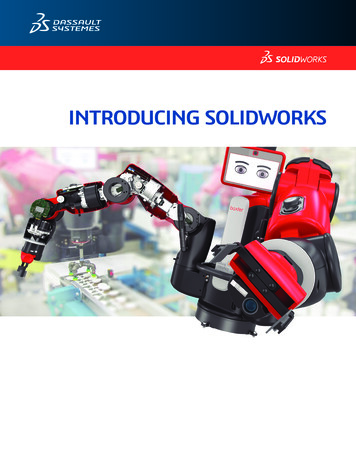
Transcription
Color profile: Generic CMYK printer profileComposite Default screenBaseTech / Networking Concepts / team / 223089-4 / Blind Folio 01Introducing BasicNetwork Concepts“In the beginning, there wereno networks. Life was bad.”—MIKE MEYERSIn this chapter, you will learnhow to: Identify human and computernetworks Describe the benefits of networks Distinguish between the differenttypes of networksNetworks are everywhere—or so it seems. You can hardly do anything withdata that does not involve a network. Like the human networks that we areall part of, computer networks let us share information and resources. In business,the reliance on networks is even more pervasive than in homes or schools.Networks help individuals and businesses alike save money, but they also helpcreate income. Without a doubt, networking within the home will catch on overthe next few years as it has in business. Soon, nearly all individuals in evenmoderately developed nations will have networked components throughout theirhomes. Those that don’t will be netologically disadvantaged because they will notbe able to learn or to function at the same level as those who are networked.In this chapter, you’ll begin by relating networks to situations and conceptsyou already know. Once you have a basic understanding of what networks areand what they can do, it helps if you can actually begin working with them. Infact, it is so helpful to learn the ropes of networking through hands-on guidedpractice that that’s what is planned for you here. You will play the role of anemployee in a fictional company, and you’ll have to learn on the job. The moreyou become the person, the more you will learn about the need for and operationof computer Monday, June 02, 2003 3:12:13 PM
Color profile: Generic CMYK printer profileComposite Default screenBaseTech / Networking Concepts / team / 223089-4 / Blind Folio 1 Understanding NetworksAlthough you are probably taking this class to learn about computer networks, and some of you probably already know how important networksare to businesses that want to survive, we will begin this discussion asthough you are an employee in a netologically disadvantaged (my term forthose who have minimal network awareness) company. You might actuallybe an employee working for such a company and trying to help it out of thatpredicament, or you may know of people or companies that are in this sortof struggle.Lauren has recently been hired as the computer manager for SinkRSwimPools. Lauren is a certified networking administrator, but her new companyunfortunately has only outdated computers. The owner recognized that thecompany’s lack of growth was directly tied to the employees’ lack of computer skills, so in her first meeting after being hired, Lauren was given theauthority to purchase the additional computers and create the network shehad proposed to the owner in her initial job interview. The owner gave her asix-month timeline in which to implement networking at SinkRSwim Poolsin such a way that the workers will understand its use and welcome the newknowledge it requires. She was also informed that the thought of learningnew computer skills frightened some long-term SinkRSwim Pools employees. The owner expects Lauren to help them become more at ease withthe computers so they will be more likely to learn the necessary skills.Lauren’s first goal is to ease the workers’ fears by teaching them aboutcomputers and showing them how a need for networks develops naturally.Lauren knows that if her fellow employees understand the concept of networking, the computer network will more likely be successful in the company.Lauren has decided to review basic network concepts with her coworkers asshe works with them on their new computers.Human NetworksIn its broadest sense, a network consists of two or more entities, or objects,sharing resources and information. Although this book is about computernetworks, there are networks that don’t involve computers, and thosenetworks are everywhere. You have grown accustomed to working withthem, possibly without even knowing it.It may not matter to you that, in a basic sense, sharing (giving or getting)is a fundamental aspect of networking. You just know that you do it.Family NetworkMost people belong to a family network in which related people share theirresources and information. This sharing is bi-directional because even theyoungest family members share information of some sort. As the familygrows, so does the network. A network connects members of afamily together.Peer NetworkOutside the family, there is a community that offers a wider array of resources than the typical family can provide. Naturally, it makes sense toChapter 1: Introducing Basic Network ay, June 02, 2003 3:12:13 PM1
Color profile: Generic CMYK printer profileComposite Default screenBaseTech / Networking Concepts / team / 223089-4 / Blind Folio 2connect the family to this community to take advantage of the wealth of resources available around town. This type of information/resource sharingcan be as simple as loaning a hammer to a neighbor, car-pooling with workassociates, or helping a friend with his or her homework. All of these activities involve sharing, or trading, resources. This kind of network is represented by a two-way relationship, a give and take among equals or peers.Restaurant Network: The Client and the Server The family network connects with thegreater community.In sidebars and the end-ofchapter exercises throughoutthis coursebook, you will beworking with a real-world company called Technology Education and Acquisition Center ofHouston (TEACH) that is currently undergoing a suddenexpansion. In fact, it has justposted an announcement in thelocal newspaper, listing severalavailable management positionswithin the company. It seemsthere is an opportunity to acquireanother highly successful facilityin another part of the state, andall the current employees aremoving. Later in the chapter,you will find yourself roleplaying as one of the replacement candidates vying for oneof the company’s 01\ch01.vpMonday, June 02, 2003 3:12:14 PMSo, in any type of human network, there’s a lot of giving and taking. You’realready more accustomed to the client/server perspective in networkingthan you realize. For instance, when you go to dinner at a restaurant, you become a customer, or client, enjoying the food and drink prepared and servedto you by the restaurant. On the other hand, the waiter works as a server,controlling and providing his customers with access to resources in the formof placing orders for and delivering food items. The server knows that requests will be made of him (access is sought when an order is placed) andthat he will service those making the requests (access is granted when theorder is delivered). In a dining situation, it is easy to know whether you are supposed to be serving orbeing served.Contact NetworkAnyone who has looked for a job knows that one of the best ways to find ajob is to network. That is, create a list of friends and associates who will helpyou find the perfect job. The more people you meet and get to know, thebetter your chances of obtaining work. As you develop and nurture your career, this contact network will serve you best because your role in it willNetworking Concepts
Color profile: Generic CMYK printer profileComposite Default screenBaseTech / Networking Concepts / team / 223089-4 / Blind Folio 3change as you gain more experience. Soon, you may be able to helpthe people who helped you. And as your personal and professionalnetworks grow, so do your opportunities.These examples of human networks should help you understand that networking is common between people and is not just anactivity restricted to computers. However, this book will focus oncomputer networks—connecting computers and having themcommunicate with each other.Computer NetworksA computer network consists of two or more computing devices thatare connected in order to share the components of your network(its resources) and the information you store there, as shown inFigure 1.1. The most basic computer network (which consists of justtwo connected computers) can expand and become more usable The more people in your network, the better yourchances of finding that perfect job.when additional computers join and add their resources to thosebeing shared.The first computer, yours, is commonly referred to as your local computer. It is more likely to be used as a location where you do work, a workstation, than as a storage or controlling location, a server. As more and morecomputers are connected to a network and share their resources, the network becomes a more powerful tool, because employees using a networkwith more information and more capability are able to accomplish morethrough those added computers or additional resources.The real power of networking computers becomes apparent if you enviFor the remainder of this text,sion your own network growing and then connecting it with other distinctthe term network will be used tonetworks, enabling communication and resource sharing across both netmean computer network.works. That is, one network can be connected to another network and become a more powerful tool because of the greater resources. For example, Figure 1.1A computer network can be as simple as two or more computerscommunicating.Chapter 1: Introducing Basic Network ay, June 02, 2003 3:12:15 PM3
Color profile: Generic CMYK printer profileComposite Default screenBaseTech / Networking Concepts / team / 223089-4 / Blind Folio 4you could connect the networkyou and your classmates developfor this course to similarly conIdentify Your Networksstructed networks from other introYou have already seen that you have been involved in networks for aductory networking classes if youlong time and that computer networks are important tools for businesses.wanted them to share your inforUse what you have learned as you answer the following questions:mation and networked resources.Those classes could be within1. Which basic human network best represents the interactionyour own school, or they could bebetween you and your classmates in a discussion about youranywhere in the world. Whereverhomework assignments?that newly joined network is, the2. If your lab had only stand-alone computers, what would becommunication and resource sharneeded to convert it to a networked classroom?ing activities in that new networkcould then be shared with anyoneconnected to your network. All you have to do is join that new network’scommunity or allow its members to join yours.In addition, a company’s cost of doing business can be reduced as aresult of sharing data (defined as a piece or pieces of information) and resources. Instead of having individual copies of the data at several locationsaround the company, and needing to keep all of them similarly updated, acompany using a network can have just one shared copy of that data andshare it, needing to keep only that one set of data updated. Furthermore,sharing networked resources (like printers) means that more people can usea particular resource and a wider variety of resources (like different printers)can be used by each network user. Any time a company can do more withless, or buy fewer items to do the same job, its total costs are reduced, and itis able to make more money per dollar spent.Cross CheckNetwork PlanNetworking computers first and tracking the connections later can quicklybecome confusing and unmanageable as you try to find which computercommunicates with and shares resources with which other computers. Inyour human network, do you share everything with your friends? In yourfamily network, would you want your parents or guardians to know yourevery thought? You have your information-sharing plan in your head, andit is important to keep track of it so you don’t make a mistake and sharesomething where it was not intended.Similar concerns must be considered while designing a computer network.Before you even connect your first computers together, you should have aplan. A network plan, therefore, is a formally created product that shows allthe network’s components and the planned connections between them.Such a plan is also used to manage the various types of information. Yourplan should show what types of information are stored where, and who isallowed to use each type.Information ManagementYour network plan should help you manage the information gathered,stored, and shared between your users. If you were given an emptythree-drawer filing cabinet and told to use it to organize your company’s information, you would have an excellent (although manual) example of a filing system that needs a plan. Having an overall guide that tells you who will4P:\010Comp\BaseTech\089-4\ch01\ch01.vpMonday, June 02, 2003 3:12:16 PMNetworking Concepts
Color profile: Generic CMYK printer profileComposite Default screenBaseTech / Networking Concepts / team / 223089-4 / Blind Folio 5be allowed access to the three drawers will help determine what you store ineach one. Once you have that part of the plan, you could put the least-usedinformation in the bottom drawer, the more-used in the middle drawer, andthe most-used in the top drawer so that it is easier for your users to accesstheir information. Knowing who needs to know what, and its corollary—who does not need to know what—lets you determine whether to lock a particular drawer, too.Even when we discuss implementing a three-drawer manual filing system, the importance of having a network plan ahead of time becomes evident. If you put the limited-access material in a drawer open to allemployees, how do you keep it secure? Additional security measures (likeadding a lock to a drawer, or moving the secure
types of networks xiv BaseTech / Networking Concepts / team / 223089-4 / Blind Folio 0 N etworks are everywhere—or so it seems. You can hardly do anything with data that does not involve a network. Like the human networks that we are all part of, computer networks let us share information and resources. In business, the reliance on networks is even more pervasive than in homes or schools .











